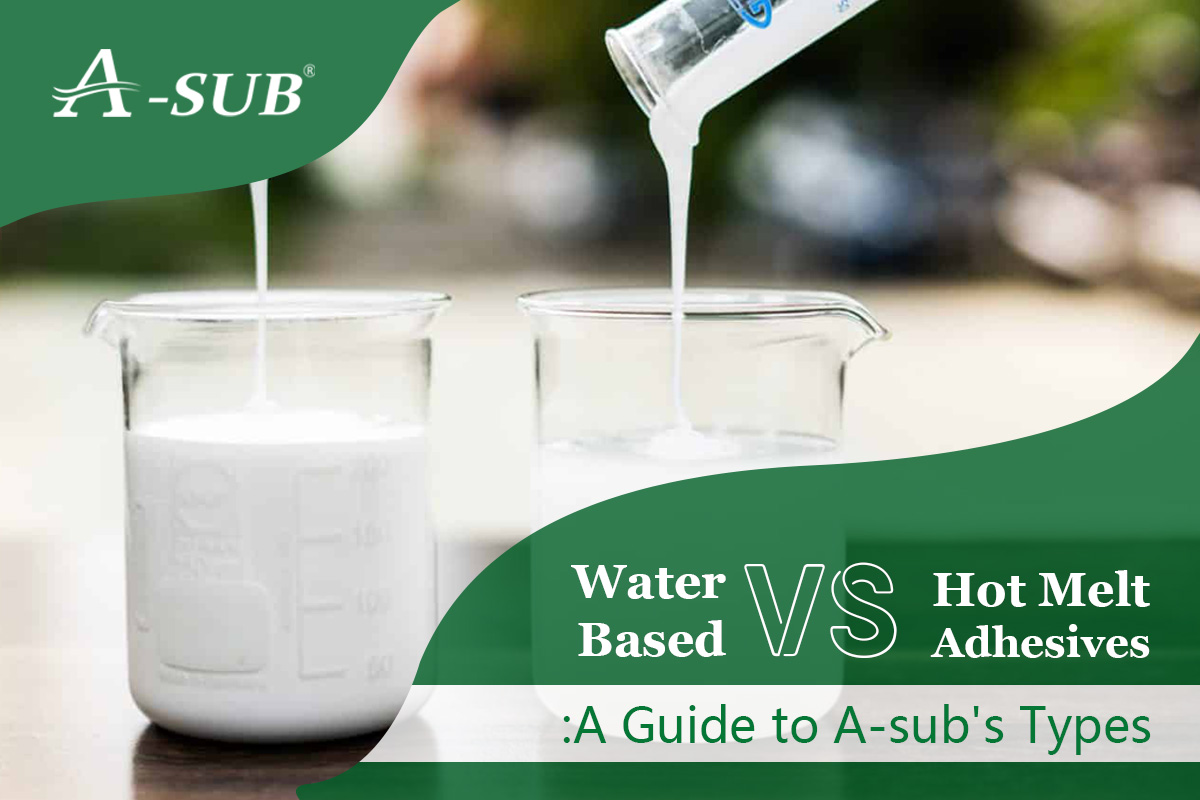A-sub offers a variety of label and photo paper products designed for different purposes, utilizing two primary types of adhesives: water-based and hot melt. Each adhesive type has distinct qualities, ensuring secure bonding while catering to various project requirements and storage conditions. This article serves as a practical guide to help you identify the adhesive type used in your A-sub labels or sheets. Understanding the differences between water-based and hot melt adhesives is crucial for selecting the most suitable option.
We will explore the unique properties of each adhesive type, including their appearance, texture, and sensitivity to temperature. Additionally, we'll provide a straightforward method to differentiate between hot melt glue and water glue. By becoming familiar with these adhesives, you can confidently choose A-sub products that meet your specific needs. Let's delve into the distinctive characteristics that distinguish water-based from hot melt bonding.
Water-based Adhesive
●Introduction to Water-based Adhesive

Water-based adhesive, as the name implies, primarily consists of water-based components. It finds widespread application in various tasks such as mounting photos, scrapbooking, and crafts.
Key features of water-based adhesive include its ease of use due to a smooth and thin consistency, facilitating simple application without creating a messy work area. Unlike permanent adhesives, items affixed with water-based glue can be easily repositioned or removed without causing surface damage, allowing for adjustments in positioning.
Moreover, it boasts low odor characteristics, emitting minimal to no smell during use. With limited volatile organic compounds (VOCs), which are responsible for odors, it offers an environmentally friendly alternative compared to solvent-based adhesives.
Water-based adhesive forms a robust, flexible bond with porous materials like paper, ensuring durability without compromising the material over time. Cleanup is effortless as spills and residue can be effectively managed with water alone, eliminating the need for chemical solvents.
Additionally, it provides a moderate working time, enabling ample opportunity to precisely position pieces before the adhesive sets completely. These qualities make water-based adhesive a preferred choice in various applications where ease of use, repositionability, and environmental considerations are paramount.
●A-sub’s Water-based Adhesive for Labels and Photos

Water-based adhesive, also known as cold glue, is applied as a thin, transparent layer on the reverse side of many A-sub products. Unlike hot melt adhesives, which solidify upon cooling, water-based adhesive remains soft and repositionable even after application. It is composed of water and other solvents, forming a gentle bond that is tactile and won't damage surfaces over time. This type of adhesive is particularly suitable for applications where adjustability is needed, such as in scrapbooking pages and light-duty signage.
Products featuring water-based adhesive allow for easy repositioning during creation without risking damage to photo papers or artworks if adjustments or removals are necessary. Its repositionable qualities make it highly favored for DIY craft and decoration projects. Beginners can confidently cut templates, letters, and shapes knowing they can adjust placement without concern for mistakes. Similarly, children can enjoy creating with papers backed by water-based adhesive, making it ideal for educational purposes and creative experimentation.
Once a project is completed, the soft adhesive coating securely holds components in place on surfaces like walls and windows while remaining gentle upon removal.
Hot Melt Adhesive
●Introduction to Hot Melt Adhesive

Hot melt adhesive, also known as heat-set or thermoplastic adhesive, is applied in a molten or liquid state and solidifies upon cooling. It offers several key characteristics:
Immediate Bonding Strength: It bonds quickly to substrates upon application and sets within seconds due to its rapid melting formula.
Permanence: Once set, the bond is typically permanent and requires heat reapplication for detachment.
Impact Resistance: Hot melt adhesive forms strong yet flexible bonds that can withstand significant impacts, vibrations, and stress loads.
Temperature Resistance: It maintains its bond strength across a wide range of temperatures, including hot and cold conditions.
Versatility: Besides paper and board, it adheres well to various materials such as plastics, metals, wood, and both porous and non-porous surfaces.
Composition: Hot melt adhesive is typically composed of synthetic resins, often thermoplastic polymers like ethylene-vinyl acetate, which melt when heated.
Application: It is applied in its molten form using tools like hot melt guns, applicators, or glue pots, typically at temperatures ranging from 180 to 200°F.
Equipment Cleaning: Equipment used for hot melt adhesive application, such as glue pots and guns, requires cleaning with solvents like acetone when switching between different types of adhesives.
●A-sub’s Hot Melt Adhesive for Labels and Photos

The reverse side of certain A-sub products features a layer of hot melt adhesive. This thermoplastic glue is applied in a molten liquid state and solidifies firmly upon cooling. It offers immediate tackiness and strong bonding capability, making it convenient for permanent attachment to nearly any surface directly from the roll. Its non-porous bonding properties make it suitable for enduring outdoor conditions and long-term displays. A-sub labels equipped with hot melt backing are commonly utilized for durable identification and commercial signage purposes.
Identifying A-sub’s Products’ Adhesive Types
To determine which type of adhesive is used in a particular A-sub product, it's important to consider several key characteristics that distinguish between water-based and hot melt options.
Appearance: Water-based adhesive appears as a smooth, clear film, whereas hot melt adhesive typically has an opaque appearance with subtle coloration. Even on light-colored paper, the thermoplastic nature of hot melt adhesive is noticeable.
Texture: Run your finger gently across the lower portion of a sample. Water-based adhesive feels pliant and slightly tacky, akin to glossy tape. In contrast, hot melt adhesive feels more rigid, with a discreet rubbery or plastic-like texture.
Flexibility: Hold a corner of the paper down and gently bend the rest back. Water-based adhesive sheets will roll into a flexible curve, whereas hot melt adhesive holds a stiffer crease.
Temperature Resistance: Wave a sample back and forth above an illuminated device like a cell phone screen. Water-based backed sheets may soften and droop slightly from generated heat waves, whereas hot melt counterparts remain firmly fixed without distortion.
Adhesion Testing: Peel up one lower corner of the paper about 1/4 inch from any surface. Water-based adhesive lifts away smoothly like cellophane, leaving no residue. Hot melt adhesive separation requires more forceful tearing and may leave behind stringy adhesive strands.
Durability: Fold a small sample in half repeatedly. Water-based adhesive may show signs of splitting over multiple folds, whereas hot melt adhesive withstands wrinkling without compromising the bond or damaging the paper.
These identification tips are essential when distinguishing between A-sub's adhesive types. For further assistance in choosing the right materials, please don't hesitate to contact our experts directly. We are committed to helping you find the perfect paper solution for your needs.
How to Choose the Right Adhesive Type for A-sub Labels and Photo Papers?
When selecting A-sub products for your crafts and projects, the adhesive backing plays a crucial role. You have two main options: water-based and hot melt adhesives, each with distinct advantages. Understanding your specific needs will guide you to the best choice.
For applications where repositioning is important, such as in scrapbooking, water-based adhesives are highly recommended. They provide a strong bond that allows for easy adjustment of photos or paper layouts. In contrast, for projects requiring a more permanent bond, hot melt adhesives offer an immediate and secure attachment that won't peel or shift over time.
The surface material you are adhering to also influences your decision. Water-based adhesives work well on porous surfaces like paper but may not adhere effectively to smooth plastics. Hot melt adhesives, on the other hand, can securely bond to a variety of materials including wood and metal.
Consider the environment where your finished project will be displayed. Water-based adhesives maintain strong adhesion indoors away from moisture, whereas hot melt adhesives can withstand moisture and are suitable for areas prone to occasional splashes like bathrooms or kitchens. For outdoor applications, hot melt adhesives are preferable due to their UV and weather resistance, whereas water-based adhesives may degrade under prolonged sunlight exposure.
If speed of bonding is crucial, hot melt adhesives provide an instant bond ideal for fast production needs. In contrast, water-based adhesives offer a longer working time, allowing you to carefully position elements before the adhesive sets.
Choosing the right A-sub product depends on evaluating specific requirements such as the material being used, the need for adjustment during application, and the display conditions for long-lasting adherence. For further assistance, feel free to contact our experts.






